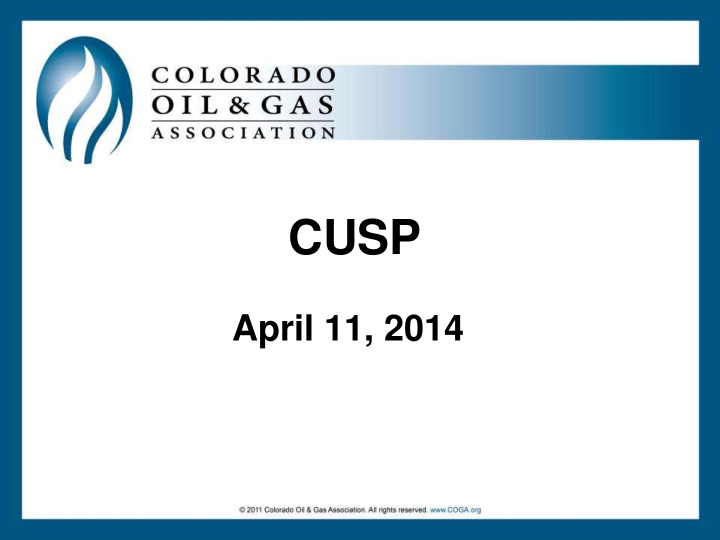



CUSP April 11, 2014
O&G in Colorado
Colorado’s O&G Industry 51,814 active wells 6 th highest state in natural gas production 9 th highest state in crude oil production $1.6B in public revenue 111,000 jobs $500 Million to Education Sources: Colorado Oil and Gas Conservation Commission, Independent Petroleum Association of America.
Active Wells
Drilling
Drilling Distance Aquifer 400-800 ft. Wells Fargo Center ~700 ft 7000 ft.
Casing Multiple layers surrounding the aquifer Cement Conductor Casing Cement Surface Casing Drilling Mud/Cement Production Casing Production Tubing
Hydraulic Fracturing Very little “conventional” production Over 95% of the wells drilled in the U.S. and in Colorado are hydraulically fractured Over 1 million wells in U.S., 2 million worldwide No Hydraulic Fracturing = No Oil and Gas
Definition The use of fluids to create a crack by hydraulic pressure The continued injection of fluids into the created crack fracture to make it grow larger The placement of small granular solids into the crack to ensure the crack remains open after the hydraulic pressure is no longer applied
Why HF a Well? Electronic Microscope Image of Rock Magnification: 1000X Filename: S0178.tif Width of a human hair 100 µm
Perforation Gun
Water is Pumped
Fractures and Proppant
Footprint 1 Well Pad or 32?
FracFocus Website 15
Water Management
Amount of Water The amount of water needed depends on the geologic basin, the formation, and the well. Raton Basin, approximately 50,000 to 300,000 gallons may be for a shallow coalbed methane well Piceance Basin, approximately 800,000 to 2 million gallons for a deeper tight sand gas well. DJ Basin, approximately 250,000 gallons may be used to frac a vertical well, while up to 5 million gallons may be used to frac a horizontal well. (Niobrara wells consistently demonstrate use of ~2.5 million gallons) Source - COGCC
Sources of Water Use of Water Must be Legally Allowed Municipal lease/purchase (industrial uses) Changed water rights (e.g. temp agricultural to industrial) Fully consumed water (leased/purchase effluent) Produced water (non-trib or decreed trib & augmented) Non-tributary (landowner & operator agreement) Source - COGCC
Colorado Water Use
Estimated Water Use 2015: 0.10% of total water use One Acre Foot is Approximately 326,000 Gallons Source: COGCC
Recycling Rates Front Range: ~50% produced water and >90% flowback water Piceance Basin: 99% produced and flowback water Southern Basins: Wells produce more water than gas, fresher than other basins
Groundwater & Surface Water Protection The prevention of adverse environmental impacts • Downhole review of casing & cementing plan • Review of Location Drawing, Hydrology Map submitted with Form 2A • Review of surrounding water wells & well data • Review of surface water features • Review of operator provided Best Management Practices (BMPs
Groundwater & Surface Water Protection COGCC Rule 317B - Public Water System Protection 3 zones measured out from surface water supply, for 5 miles upstream of intake 1.External Buffer: 501 – 2640’. Pitless drilling or lined pits, surface water sampling, notification to PWS, emergency spill response. 2.Intermediate Buffer: 301 – 500’. Pitless drilling, lined and oversized secondary containment, all others as required for external. 3.Internal Buffer: 0 – 300’. Variance request required, plus all requirements for Intermediate.
Conditions of Approval (COA) Technically feasible, economically practicable COAs may be placed on a Form 2 or Form 2A to respond to public health, safety and welfare concerns identified during staff review. • Lined drilling pits or closed-loop (pitless) drilling systems; • Lined tank batteries; • Water well sampling, including baseline; • Slope stabilization; • Additional high density operational requirements.
Baseline Water Sampling Pre and Post-drilling water samples taken around new well starts Increased transparency & accountability for industry Database Active
Visit US! Andrew.Casper@coga.org 303-861-0362 Facebook: COGA Twitter: @ColoradoOilGas www.coga.org Fact Sheets Press Releases Events Membership
Recommend
More recommend